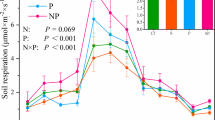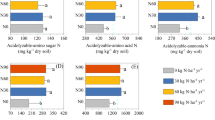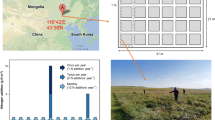Abstract
Soil nitrous oxide (N2O) fluxes are affected by variations in nitrogen (N) and water inputs. Researchers are concerned about whether differences in environmental and biological factors can explain variations in soil N2O fluxes in response to N and water additions. In June 2017, we conducted an N and water application experiment on a temperate steppe in Inner Mongolia, Northeast China, to investigate the impacts of N and water additions upon N2O fluxes and how the soil physicochemical properties, vegetation, and microbes regulate this process. In this study, we collected samples and measured the variations in soil N2O fluxes and physicochemical and biological properties under N and water additions in July and August of 2019 and 2020. The results indicated that N addition significantly decreased soil pH, increased the ammonium nitrogen (NH4+-N) and dissolved organic nitrogen (DON) contents, decreased the microbial biomass carbon (MBC) content, and promoted peroxidase (PER) activity, while water addition significantly increased soil pH, soil water content (SWC), and the root-shoot ratio. Soil N2O fluxes significantly increased by 2.2 times under the 2020 N treatment alone. A structural equation model (SEM) showed that the soil N2O fluxes in response to N and water additions were mainly driven by DON in 2019, and pH was the key factor that affected the N2O fluxes in 2020. Our findings suggested that N and water additions altered soil N contents and affected microbial activity by changing pH and plant growth conditions, which in turn regulated soil N2O fluxes.







Similar content being viewed by others
Data Availability
The data used and/or analyzed during the current study are available from the corresponding author upon reasonable request.
References
Baggs EM, Smales CL, Bateman EJ (2010) Changing pH shifts the microbial source as well as the magnitude of N2O emission from soil. Biol Fertil Soils 46:793–805. https://doi.org/10.1007/s00374-010-0484-6
Bateman EJ, Baggs EM (2005) Contributions of nitrification and denitrification to N2O emissions from soils at different water-filled pore space. Biol Fertil Soils 41:379–388. https://doi.org/10.1007/s00374-005-0858-3
Ben Keane J, Hartley IP, Taylor CR et al (2023) Grassland responses to elevated CO2 determined by plant-microbe competition for phosphorus. Nat Geosci 16:704–709. https://doi.org/10.1038/s41561-023-01225-z
Brin L, Goyer C, Zebarth B et al (2019) Linking changes in snow cover with microbial nitrogen cycling functional gene abundance and expression in agricultural soil. Fems Microbiol Ecol 95. https://doi.org/10.1093/femsec/fiz073
Butterbach-Bahl K, Baggs EM, Dannenmann M et al (2013) Nitrous oxide emissions from soils: how well do we understand the processes and their controls? Philos Trans R Soc Lond B Biol Sci 368:20130122. https://doi.org/10.1098/rstb.2013.0122
Cantarel AAM, Bloor JMG, Pommier T et al (2012) Four years of experimental climate change modifies the microbial drivers of N2O fluxes in an upland grassland ecosystem. Glob Chang Biol 18:2520–2531. https://doi.org/10.1111/j.1365-2486.2012.02692.x
Chen G (1999) Current status of soil microbial biomass determination methods and their application in red earth. Chin J Soil Sci 284–287 (in Chinese). https://doi.org/10.19336/j.cnki.trtb.1999.06.016
Chen C, Xiao W (2022) The global positive effect of phosphorus addition on soil microbial biomass. Soil Biol Biochem 176:108882. https://doi.org/10.1016/j.soilbio.2022.108882
Cui P, Chen Z, Fan F et al (2023) Soil texture is an easily overlooked factor affecting the temperature sensitivity of N2O emissions. Sci Total Environ 862:160648. https://doi.org/10.1016/j.scitotenv.2022.160648
Du Y, Ke X, Li J et al (2021) Nitrogen deposition increases global grassland N2O emission rates steeply: a meta-analysis. Catena (amst) 199:105105. https://doi.org/10.1016/j.catena.2020.105105
Feng R, Li Z (2023) Current investigations on global N2O emissions and reductions: prospect and outlook. Environ Pollut 338:122664. https://doi.org/10.1016/j.envpol.2023.122664
Fischer EM, Knutti R (2015) Anthropogenic contribution to global occurrence of heavy-precipitation and high-temperature extremes. Nat Clim Chang 5:560–564. https://doi.org/10.1038/nclimate2617
Fu Y, Liu C, Lin F et al (2018) Quantification of year-round methane and nitrous oxide fluxes in a typical alpine shrub meadow on the Qinghai-Tibetan plateau. Agric Ecosyst Environ 255:27–36. https://doi.org/10.1016/j.agee.2017.12.003
Geng S, Chen Z, Han S et al (2017) Rainfall reduction amplifies the stimulatory effect of nitrogen addition on N2O emissions from a temperate forest soil. Sci Rep 7:43329. https://doi.org/10.1038/srep43329
Geng F, Li K, Liu X et al (2019) Long-term effects of n deposition on N2O emission in an alpine grassland of central Asia. Catena (amst) 182:104100. https://doi.org/10.1016/j.catena.2019.104100
Giagnoni L, Pastorelli R, Mocali S et al (2016) Availability of different nitrogen forms changes the microbial communities and enzyme activities in the rhizosphere of maize lines with different nitrogen use efficiency. Appl Soil Ecol 98:30–38. https://doi.org/10.1016/j.apsoil.2015.09.004
Glick BR, Gamalero E (2021) Recent developments in the study of plant microbiomes. Microorganisms 9:1533. https://doi.org/10.3390/microorganisms9071533
Gu X, Wang Y, Laanbroek HJ et al (2019) Saturated N2O emission rates occur above the nitrogen deposition level predicted for the semi-arid grasslands of Inner Mongolia, China. Geoderma 341:18–25. https://doi.org/10.1016/j.geoderma.2019.01.002
Guo Q (2019) Soil acidification induced by nitrogen addition and its responses to water addition in Inner Mongolia Temperate Steppe, China. Chin J Appl Ecol 30:3285–3291. https://doi.org/10.13287/j.1001-9332.201910.022. (in Chinese)
Guo P, Zhang C, Wang Y et al (2018) Effect of long-term fertilization on humic redox mediators in multiple microbial redox reactions. Environ Pollut 234:107–114. https://doi.org/10.1016/j.envpol.2017.10.106
Guo Y, Dong Y, Peng Q et al (2022) Effects of nitrogen and water addition on N2O emissions in temperate grasslands, northern China. Appl Soil Ecol 177:104548. https://doi.org/10.1016/j.apsoil.2022.104548
Harpole WS, Potts DL, Suding KN (2007) Ecosystem responses to water and nitrogen amendment in a California grassland. Glob Chang Biol 13:2341–2348. https://doi.org/10.1111/j.1365-2486.2007.01447.x
He M, Duan P, Li D (2022) Review on the pathways of soil nitrous oxide production and its research methods. Chin J Ecol, 1–12 (in Chinese). https://doi.org/10.13292/j.1000-4890.202306.001
Hu H, Chen D, He J (2015) Microbial regulation of terrestrial nitrous oxide formation: understanding the biological pathways for prediction of emission rates. Fems Microbiol Rev 39:729–749. https://doi.org/10.1093/femsre/fuv021
Hu Y, Zhan Z, Yan G et al (2021) Increases in substrate availability and decreases in soil pH drive the positive effects of nitrogen addition on soil net nitrogen mineralization in a temperate meadow steppe. Pedobiologia 89:150756. https://doi.org/10.1016/j.pedobi.2021.150756
Huang R, Wang Y, Liu J et al (2019) Variation in N2O emission and N2O related microbial functional genes in straw- and biochar-amended and non-amended soils. Appl Soil Ecol 137:57–68. https://doi.org/10.1016/j.apsoil.2019.01.010
Huntington TG (2006) Evidence for intensification of the global water cycle: review and synthesis. J Hydrol 319:83–95. https://doi.org/10.1016/j.jhydrol.2005.07.003
Jantalia CP, Dos Santos HP, Urquiaga S et al (2008) Fluxes of nitrous oxide from soil under different crop rotations and tillage systems in the south of Brazil. Nutr Cycl Agroecosyst 82:161–173. https://doi.org/10.1007/s10705-008-9178-y
Jones CM, Spor A, Brennan FP et al (2014) Recently identified microbial guild mediates soil N2O sink capacity. Nat Clim Chang 4:801–805. https://doi.org/10.1038/nclimate2301
Krüger M, Potthast K, Michalzik B et al (2021) Drought and rewetting events enhance nitrate leaching and seepage-mediated translocation of microbes from beech forest soils. Soil Biol Biochem 154:108153. https://doi.org/10.1016/j.soilbio.2021.108153
Li Z, Zeng Z, Tian D et al (2020) Global patterns and controlling factors of soil nitrification rate. Glob Chang Biol 26:4147–4157. https://doi.org/10.1111/gcb.15119
Li Z, Zeng Z, Song Z et al (2022) Variance and main drivers of field nitrous oxide emissions: a global synthesis. J Clean Prod 353:131686. https://doi.org/10.1016/j.jclepro.2022.131686
Liang X, Zhang T, Lu X et al (2020) Global response patterns of plant photosynthesis to nitrogen addition: a meta-analysis. Glob Chang Biol 26:3585–3600. https://doi.org/10.1111/gcb.15071
Liu X, Duan L, Mo J et al (2011) Nitrogen deposition and its ecological impact in China: an overview. Environ Pollut 159:2251–2264. https://doi.org/10.1016/j.envpol.2010.08.002
Liu X, Zhang Y, Han W et al (2013) Enhanced nitrogen deposition over China. Nature 494:459–462. https://doi.org/10.1038/nature11917
Liu X, Dong Y, Qi Y et al (2015) Response of N2O emission to water and nitrogen addition in temperate typical steppe soil in inner Mongolia, China. Soil Tillage Res 151:9–17. https://doi.org/10.1016/j.still.2015.01.008
Lu M, Yang Y, Luo Y et al (2011) Responses of ecosystem nitrogen cycle to nitrogen addition: a meta-analysis. New Phytol 189:1040–1050. https://doi.org/10.1111/j.1469-8137.2010.03563.x
Ma H, Bai G, Sun Y et al (2016) Opposing effects of nitrogen and water addition on soil bacterial and fungal communities in the Inner Mongolia steppe: a field experiment. Appl Soil Ecol 108:128–135. https://doi.org/10.1016/j.apsoil.2016.08.008
Mao X, Cheng M, Xu Q et al (2016) Effects of nitrification inhibitors on soil N2O emission and community structure and abundance of ammonia oxidation microorganism in soil under extensively managed Phyllostachys edulis stand. Acta Pedol Sin 53(06):1528–1540. https://doi.org/10.11766/trxb201603120052. (in Chinese)
Mathieu O, Hénault C, Lévêque J et al (2006) Quantifying the contribution of nitrification and denitrification to the nitrous oxide flux using 15N tracers. Environ Pollut 144:933–940. https://doi.org/10.1016/j.envpol.2006.02.005
Nie C (2019) Response of CO2 and N2O emissions to nitrogen and water addition in typical grassland of Inner Mongolia. Master’s Thesis, Beijing Normal University, Beijing, China (in Chinese).
Niu S, Yang H, Zhang Z et al (2009) Non-additive effects of water and nitrogen addition on ecosystem carbon exchange in a temperate steppe. Ecosystems 12:915–926. https://doi.org/10.1007/s10021-009-9265-1
Ouyang Y, Evans SE, Friesen ML et al (2018) Effect of nitrogen fertilization on the abundance of nitrogen cycling genes in agricultural soils: a meta-analysis of field studies. Soil Biol Biochem 127:71–78. https://doi.org/10.1016/j.soilbio.2018.08.024
Peng Q, Qi Y, Dong Y et al (2013) Responses of carbon cycling key processes to precipitation changes in arid and semiarid grassland ecosystems: a review. Prog Geog 31:1510–1518. https://doi.org/10.11820/dlkxjz.2012.11.012. (in Chinese)
Prosser JI, Hink L, Gubry-Rangin C et al (2020) Nitrous oxide production by ammonia oxidizers: physiological diversity, niche differentiation and potential mitigation strategies. Glob Chang Biol 26:103–118. https://doi.org/10.1111/gcb.14877
Ravishankara AR, Daniel JS, Portmann RW (2009) Nitrous oxide (N2O): the dominant ozone-depleting substance emitted in the 21st century. Science 326:123–125. https://doi.org/10.1126/science.1176985
Ren F, Yang X, Zhou H et al (2016) Contrasting effects of nitrogen and phosphorus addition on soil respiration in an alpine grassland on the Qinghai-Tibetan plateau. Sci Rep 6:34786. https://doi.org/10.1038/srep34786
Reynolds LL, Johnson BR, Pfeifer-Meister L et al (2015) Soil respiration response to climate change in Pacific Northwest prairies is mediated by a regional Mediterranean climate gradient. Glob Chang Biol 21:487–500. https://doi.org/10.1111/gcb.12732
Rousk J, Bååth E, Brookes PC et al (2010) Soil bacterial and fungal communities across a pH gradient in an arable soil. ISME J 4:1340–1351. https://doi.org/10.1038/ismej.2010.58
Schwinning S, Starr BI, Ehleringer JR (2005) Summer and winter drought in a cold desert ecosystem (Colorado Plateau) part I: effects on soil water and plant water uptake. J Arid Environ 60:547–566. https://doi.org/10.1016/j.jaridenv.2004.07.003
Shang S, Song M, Wang C et al (2023) Decrease of nitrogen cycle gene abundance and promotion of soil microbial-N saturation restrain increases in N2O emissions in a temperate forest with long-term nitrogen addition. Chemosphere 338:139378. https://doi.org/10.1016/j.chemosphere.2023.139378
Shcherbak I, Millar N, Robertson GP (2014) Global meta-analysis of the nonlinear response of soil nitrous oxide (N2O) emissions to fertilizer nitrogen. Proc Natl Acad Sci U S A 111:9199–9204. https://doi.org/10.1073/pnas.1322434111
Shi Z, Weiner J, Cavalieri A, et al (2021) The interaction between N and P addition on grassland soil acid buffering capacity is regulated by precipitation. Soil Sci Plant Nutr 1–11. https://doi.org/10.1080/00380768.2021.1892457
Sinsabaugh RL (2010) Phenol oxidase, peroxidase and organic matter dynamics of soil. Soil Biol Biochem 42:391–404. https://doi.org/10.1016/j.soilbio.2009.10.014
Stevens RJ, Laughlin RJ, Malone JP (1998) Soil pH affects the processes reducing nitrate to nitrous oxide and di-nitrogen. Soil Biol Biochem 30:1119–1126. https://doi.org/10.1016/S0038-0717(97)00227-7
Sun Z, Wang L, Tian H et al (2013) Fluxes of nitrous oxide and methane in different coastal Suaeda salsa marshes of the Yellow River estuary, China. Chemosphere 90:856–865. https://doi.org/10.1016/j.chemosphere.2012.10.004
Tian H, Xu R, Canadell JG et al (2020) A comprehensive quantification of global nitrous oxide sources and sinks. Nature 586:248–256. https://doi.org/10.1038/s41586-020-2780-0
Wan X, Chen X, Huang Z et al (2021) Contribution of root traits to variations in soil microbial biomass and community composition. Plant Soil 460:483–495. https://doi.org/10.1007/s11104-020-04788-7
Wang Y, Guo J, Vogt RD et al (2018) Soil pH as the chief modifier for regional nitrous oxide emissions: new evidence and implications for global estimates and mitigation. Glob Chang Biol 24:e617–e626. https://doi.org/10.1111/gcb.13966
Wang Y, Wang D, Shi B et al (2020) Differential effects of grazing, water, and nitrogen addition on soil respiration and its components in a meadow steppe. Plant Soil 447:581–598. https://doi.org/10.1007/s11104-019-04410-5
Wei P, Pan X, Xu L et al (2019) The effects of topography on aboveground biomass and soil moisture at local scale in dryland grassland ecosystem, China. Ecol Indic 105:107–115. https://doi.org/10.1016/j.ecolind.2019.05.002
Wen S, Tian Y, Ouyang S et al (2021) High frequency of extreme precipitation increases stipa grandis biomass by altering plant and microbial nitrogen acquisition. Biol Fertil Soils 58:63–75. https://doi.org/10.1007/s00374-021-01608-7
Wu Y, Gao X, Cao D et al (2021) Nitrous oxide emissions from an alpine grassland as affected by nitrogen addition. Atmosphere. https://doi.org/10.3390/atmos12080976
Xu W, Zhao M, Ren R et al (2022) Grazing amplifies the stimulating effects of N addition on N2O emissions in a temperate meadow steppe. Agric Ecosyst Environ 339:108143. https://doi.org/10.1016/j.agee.2022.108143
Yang WH, Silver WL (2016) Gross nitrous oxide production drives net nitrous oxide fluxes across a salt marsh landscape. Glob Chang Biol 22:2228–2237. https://doi.org/10.1111/gcb.13203
Yang H, Wu M, Liu W et al (2011) Community structure and composition in response to climate change in a temperate steppe. Glob Chang Biol 17:452–465. https://doi.org/10.1111/j.1365-2486.2010.02253.x
Yang Y, Xiao Y, Li C et al (2021) Nitrogen addition, rather than altered precipitation, stimulates nitrous oxide emissions in an alpine steppe. Ecol Evol 11:15153–15163. https://doi.org/10.1002/ece3.8196
Yao H, Campbell CD, Chapman SJ et al (2013) Multi-factorial drivers of ammonia oxidizer communities: evidence from a national soil survey. Environ Microbiol 15:2545–2556. https://doi.org/10.1111/1462-2920.12141
Yu G, Jia Y, He N et al (2019) Stabilization of atmospheric nitrogen deposition in China over the past decade. Nat Geosci 12:424–429. https://doi.org/10.1038/s41561-019-0352-4
Zhang F, Qi J, Li F et al (2010) Quantifying nitrous oxide emissions from Chinese grasslands with a process-based model. Biogeosci Discuss 7:2039–2050. https://doi.org/10.5194/bgd-7-1675-2010
Zhang J, Kang R, Zhao B et al (2013) Monitoring nitrogen deposition on temperate grassland in Inner Mongolia. Chin J Environ Sci 34:3552–3556. https://doi.org/10.13227/j.hjkx.2013.09.013. (in Chinese)
Zhang X, Wei H, Chen Q et al (2014) The counteractive effects of nitrogen addition and watering on soil bacterial communities in a steppe ecosystem. Soil Biol Biochem 72:26–34. https://doi.org/10.1016/j.soilbio.2014.01.034
Zhang L, Hou L, Guo D et al (2017) Interactive impacts of nitrogen input and water amendment on growing season fluxes of CO2, CH4, and N2O in a semiarid grassland, Northern China. Sci Total Environ 578:523–534. https://doi.org/10.1016/j.scitotenv.2016.10
Zhang Y, Zhao W, Cai Z et al (2018) Heterotrophic nitrification is responsible for large rates of N2O emission from subtropical acid forest soil in China. Eur J Soil Sci 69:646–654. https://doi.org/10.1111/ejss.12557
Zhang J, He P, Liu Y et al (2021) Soil properties and microbial abundance explain variations in N2O fluxes from temperate steppe soil treated with nitrogen and water in Inner Mongolia. China Appl Soil Ecol 165:103984. https://doi.org/10.1016/j.apsoil.2021.103984
Funding
This work was supported by National Key Research and Development Program of China (grant no. 2022YFF1302803) and National Natural Science Foundation of China (grant no. 31770519).
Author information
Authors and Affiliations
Contributions
QD: formal analysis, visualization, writing—original draft, and writing—review and editing; YL: conceptualization, funding acquisition, supervision, and writing—review and editing; PH: data curation and investigation; WD: data curation and investigation.
Corresponding author
Ethics declarations
Competing Interests
The authors declare no competing interests.
Additional information
Publisher's Note
Springer Nature remains neutral with regard to jurisdictional claims in published maps and institutional affiliations.
Supplementary Information
Below is the link to the electronic supplementary material.
Rights and permissions
Springer Nature or its licensor (e.g. a society or other partner) holds exclusive rights to this article under a publishing agreement with the author(s) or other rightsholder(s); author self-archiving of the accepted manuscript version of this article is solely governed by the terms of such publishing agreement and applicable law.
About this article
Cite this article
Dong, Q., Liu, Y., He, P. et al. Belowground Biomass Changed the Regulatory Factors of Soil N2O Funder N and Water Additions in a Temperate Steppe of Inner Mongolia. J Soil Sci Plant Nutr 24, 606–617 (2024). https://doi.org/10.1007/s42729-023-01569-w
Received:
Accepted:
Published:
Issue Date:
DOI: https://doi.org/10.1007/s42729-023-01569-w




